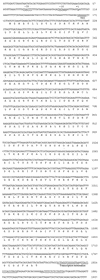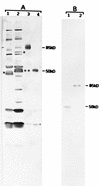Molecular basis for antigenic variation of a protective strain-specific antigen of Ehrlichia risticii
- PMID: 9673249
- PMCID: PMC108402
- DOI: 10.1128/IAI.66.8.3682-3688.1998
Molecular basis for antigenic variation of a protective strain-specific antigen of Ehrlichia risticii
Abstract
Ehrlichia risticii, the causative agent of Potomac horse fever, has recently been isolated from many vaccinated horses with typical clinical signs of the disease. The heterogeneity of the E. risticii isolates obtained from the vaccinated horses necessitates the identification of the molecular basis of strain variations to elucidate the vaccine failure and to aid in the development of an efficient vaccine against this disease. As an attempt, two major cross-reacting surface antigen genes of 50- and 85-kDa antigens, present separately in strains 25-D (isolated in 1984) and 90-12 (isolated in 1990 from a vaccinated horse), respectively, were cloned and sequenced. A comparative sequence analysis revealed differences and similarities between these two antigens with strain-specific sizes (SSA). The 2.5- and 1.6-kb genes coding for the 85- and 50-kDa proteins, respectively, contained many different tandem repeats. The identical repeat motifs were more frequent in the middle of both genes, but the numbers and positions of the repeats were altogether different in the genes. Many of these direct repeats of both genes had exact sequence homology and coded for the same amino acids. The homology of the 5'- and 3'-flanking regions of the two genes was greater than that of the regions in the central part of the genes. A comparative analysis of the deduced amino acid sequences of these two antigen genes indicated eight common domains, which were designated identical domains. Although the sequence homologies of these identical domains were the same, the positions of the domains in their respective strains were completely different. This finding might be one of the bases of antigenic variation between the strains. In addition, there were a few unique regions in both antigen genes where no sequence homology existed. These specific regions were designated unique domains. The 50-kDa protein had two such unique domains, and the 85-kDa protein had six such unique domains. The presence of such unique domains contributed to the large size variation of these SSA. The cross-reactivity of recombinant proteins confirmed the presence of conserved epitopes between these two antigens. The SSA have been determined to be apparent protective antigens of E. risticii.
Figures





Similar articles
-
Cloning and molecular analysis of genes encoding two immunodominant antigens of Ehrlichia risticii.Microb Pathog. 1998 Jun;24(6):361-72. doi: 10.1006/mpat.1998.0208. Microb Pathog. 1998. PMID: 9632540
-
Association of deficiency in antibody response to vaccine and heterogeneity of Ehrlichia risticii strains with Potomac horse fever vaccine failure in horses.J Clin Microbiol. 1998 Feb;36(2):506-12. doi: 10.1128/JCM.36.2.506-512.1998. J Clin Microbiol. 1998. PMID: 9466767 Free PMC article.
-
Diversity of 16S rRNA genes of new Ehrlichia strains isolated from horses with clinical signs of Potomac horse fever.Int J Syst Bacteriol. 1995 Apr;45(2):315-8. doi: 10.1099/00207713-45-2-315. Int J Syst Bacteriol. 1995. PMID: 7537065
-
Studies with recombinant proteins of Ehrlichia risticii: identification of strain-specific antigen as a protective antigen.Vet Parasitol. 1998 Apr 15;76(3):189-202. doi: 10.1016/s0304-4017(97)00209-4. Vet Parasitol. 1998. PMID: 9615953
-
Pathogenic, immunologic, and molecular differences between two Ehrlichia risticii strains.J Clin Microbiol. 1995 Nov;33(11):2987-93. doi: 10.1128/jcm.33.11.2987-2993.1995. J Clin Microbiol. 1995. PMID: 8576359 Free PMC article.
Cited by
-
Plasticity of repetitive DNA sequences within a bacterial (Type IV) secretion system component.J Exp Med. 2003 Nov 3;198(9):1349-60. doi: 10.1084/jem.20030381. Epub 2003 Oct 27. J Exp Med. 2003. PMID: 14581606 Free PMC article.
-
Isolation and Molecular Analysis of a Novel Neorickettsia Species That Causes Potomac Horse Fever.mBio. 2020 Feb 25;11(1):e03429-19. doi: 10.1128/mBio.03429-19. mBio. 2020. PMID: 32098825 Free PMC article.
-
Analysis of complete genome sequence of Neorickettsia risticii: causative agent of Potomac horse fever.Nucleic Acids Res. 2009 Oct;37(18):6076-91. doi: 10.1093/nar/gkp642. Epub 2009 Aug 6. Nucleic Acids Res. 2009. PMID: 19661282 Free PMC article.
-
Proteomic analysis of Neorickettsia sennetsu surface-exposed proteins and porin activity of the major surface protein P51.J Bacteriol. 2010 Nov;192(22):5898-905. doi: 10.1128/JB.00632-10. Epub 2010 Sep 10. J Bacteriol. 2010. PMID: 20833807 Free PMC article.
-
An Ecotype of Neorickettsia risticii Causing Potomac Horse Fever in Canada.Appl Environ Microbiol. 2016 Sep 16;82(19):6030-6. doi: 10.1128/AEM.01366-16. Print 2016 Oct 1. Appl Environ Microbiol. 2016. PMID: 27474720 Free PMC article.
References
-
- Dutta S K, Rice R M, Hughes T D, Savage P K, Myrup A C. Detection of serum antibodies against Ehrlichia risticii in Potomac horse fever by enzyme-linked-immunosorbent assay. Vet Immunol Immunopathol. 1987;14:85–92. - PubMed
MeSH terms
Substances
Associated data
- Actions
- Actions
LinkOut - more resources
Full Text Sources
Research Materials

